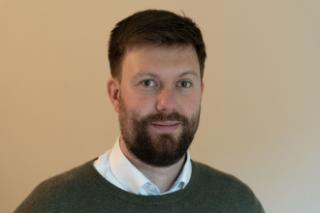Dr Ross Millar
Published: 21 August 2019
Quantum Sensors, Imaging and Data Security

Dr Ross Millar ross.millar@glasgow.ac.uk
School of Engineering
Type of fellowship Royal Academy of Engineering
Area of research Electrical and Nanoscale Engineering
Why did you choose to pursue a fellowship in your research career?
I chose to pursue a fellowship as a means to becoming academically independent; it’s a great opportunity to build a research team and develop my research, and the Royal Academy of Engineering fellowship gives me 5 years to achieve this. I think it will be a good balance between having freedom to direct the focus of my own research, and having support from both my official mentor, and other academics and colleagues at the University.
Why work at the University of Glasgow?
I can’t get enough of the rain...
Actual answer: The University of Glasgow has state of the art nanofabrication facilities available at the James Watt Nanofabrication Centre, which is essential for my project. Glasgow also leads QuantIC, which is the UK Quantum Technology Hub for developing quantum enhanced imaging technologies. My project aligns very well with this work, and the School’s research aims. It also means that I have a supportive environment to develop as an independent researcher, with significant expertise at hand.
How would you describe your research in 20 words or less?
Developing low cost, ultrasensitive sensors that can image through fog and create 3D images, and also secure our internet.
What is your research highlight?
In terms of sheer relief, I’d say handing in my PhD thesis!
In terms of the actual research; I’ve previously worked on detectors that can detect and count single photons of light, with Prof Douglas Paul and Prof Gerald Buller (Heriot Watt), and we designed a detector with a step-change in performance, with around a 50 X enhancement in sensitivity compared to the prior-art.
I’ve also previously worked on ways to engineer low cost materials to give them new optical properties. Essentially, I’m going to use these techniques to design new types of single photon detectors that can work at new wavelengths (colours) of light, and therefore open the doors to new applications.
What do you look for in a collaboration?
In a collaborator I look for someone with complementary skills or capabilities, that can further the research. Working with industry can also be extremely useful to help understand the needs and requirements of certain markets – this means that I can make sure the detectors and optical systems I make have real potential to be useful for real world applications. For this project I’ve had discussions with companies that would either be end users or form part of the supply chain to commercialise my devices.
How do you see your research impacting society?
With my technology, it will be possible to build affordable 3D imaging systems for collision avoidance in autonomous or driverless cars, which can see through fog and rain. Every year there are around 26,000 people killed or seriously injured in road accidents in the UK alone, and technologies like this can hopefully reduce this significantly, as well as providing a boost to the UK economy. One of the key things to allow the UK to take a leading role in the autonomous vehicle industry is to develop affordable sensor technologies at an early stage.
Another key area my research applies to is ensuring data sent over the internet is secure. In the coming years, it’s likely that data transmitted over optical fibre networks could become vulnerable, and personal, banking, or government data could be intercepted. With my sensors, it’s possible to exploit the quantum properties of light to guarantee that someone intercepting data is detected, and the data is kept secure.
The technology I’m developing will also allow me to make sensors that work with mid-infrared light. Greenhouse gases can block mid-infrared light, which means you can measure the presence of the gas with a mid-infrared detector. I’m going to exploit this effect so I can make low cost methane sensors, so that leaks, for example in natural gas pipelines, can be found easily and repaired. This could help reduce global warming.
What next?
Next I’ll be looking to recruit PhD students to start working on this project, and assembling a team with the skills I need to develop my technology. During the project I aim to generate Intellectual Property and I hope to be able to get my technology to market through license agreements. Ultimately I’d like to have a permanent position as a lecturer with an established research group doing exciting research in this area.
First published: 21 August 2019

